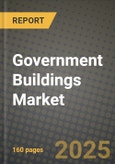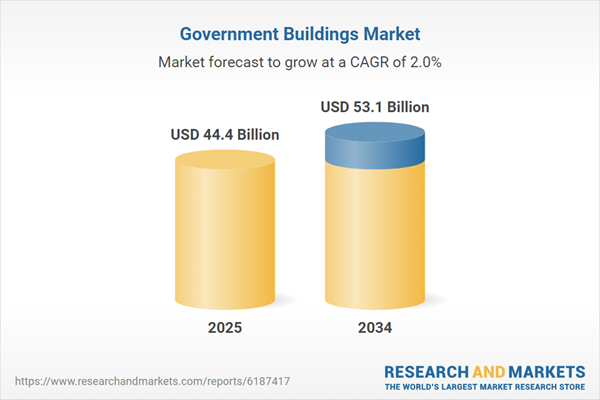Government Buildings Market Overview
The government buildings market plays a crucial role in national infrastructure development, encompassing the construction, renovation, and maintenance of structures used for administrative, legislative, judicial, and public service functions. These facilities range from courthouses and city halls to federal offices and public safety buildings, all serving as operational hubs for governance and public interaction. The market is deeply influenced by budget allocations, urban development policies, and population growth, especially in rapidly expanding cities. In recent years, the market has seen increasing demand driven by the need for sustainable building practices, energy efficiency upgrades, and modernization of outdated structures. With governments worldwide aiming to optimize space utilization and improve public access to services, investment in technologically advanced and accessible government buildings has gained momentum. Additionally, strategic public-private partnerships (PPPs) are increasingly being used to fund large-scale infrastructure projects, boosting the overall momentum of the sector.The government buildings market experienced noticeable growth, spurred by post-pandemic infrastructure spending and climate-conscious policies. Several countries increased budgetary allocations toward retrofitting existing facilities to meet green building standards, which included upgrades to HVAC systems, lighting, and insulation. The integration of smart building technologies also surged, with governments adopting IoT-enabled monitoring systems to enhance operational efficiency and reduce energy consumption. Geopolitical stability in key regions such as North America and parts of Asia-Pacific supported consistent construction activity, while emerging economies focused on building local governance centers to accommodate decentralization efforts. Moreover, digital transformation of government services fueled the need for redesigned spaces that blend physical and digital service points. Increased focus on disaster-resilient structures, especially in regions prone to climate-related risks, also shaped the development trajectory. The year marked a turning point in prioritizing resilience, sustainability, and user-centric government facilities that meet modern standards.
The government buildings market is expected to experience a steady shift toward modular construction, net-zero energy buildings, and AI-powered facility management systems. Governments are likely to continue investing in long-term infrastructure development, particularly in underserved and rural areas, to improve administrative outreach and ensure equitable access to services. Urban expansion and smart city initiatives will further drive the development of integrated government complexes designed for multi-purpose use. Advances in construction technology, including 3D printing and digital twin modeling, are anticipated to speed up project timelines and reduce costs. Additionally, sustainability goals under global frameworks such as the Paris Agreement will compel governments to incorporate renewable energy systems and environmentally responsible materials into new and renovated buildings. Public sector initiatives will increasingly reflect a balance of cost-efficiency, security, and environmental stewardship, shaping the future of government infrastructure globally.
Key Insights: Government Buildings Market
- Growing adoption of smart building technologies enables governments to monitor and optimize energy use, security, and maintenance in real-time, leading to enhanced efficiency and lower operational costs across administrative buildings.
- Increased focus on green certifications like LEED and BREEAM is transforming how government buildings are designed, emphasizing sustainable materials, energy efficiency, and reduced environmental impact.
- Rise in public-private partnerships is providing alternative funding avenues for large-scale infrastructure projects, promoting timely completion and improved management of government buildings.
- Integration of multi-functional government service centers is streamlining public access to various administrative services under one roof, improving service delivery and reducing space redundancies.
- Use of prefabricated and modular construction techniques is accelerating project delivery times and reducing construction waste, especially in remote or high-demand urban locations.
- Government initiatives for urban development and smart city infrastructure are fueling demand for modernized, digitally integrated public administration buildings across regions.
- Increasing focus on environmental sustainability and carbon footprint reduction is driving retrofits and the construction of energy-efficient, eco-friendly government facilities.
- Rising population and urban migration necessitate the expansion of public service infrastructure, including government offices and local administrative centers.
- Technological advancements in building automation and management systems are encouraging governments to upgrade existing buildings for better service delivery and efficiency.
- Budgetary constraints and shifting political priorities often delay or limit the scope of infrastructure projects, posing challenges in planning, financing, and executing government building initiatives at scale.
Government Buildings Market Segmentation
By Type
- Institutional Buildings
- Commercial Buildings
By Building Type
- Non-Residential Smart Buildings
- Traditional Buildings
By End-User
- Private
- Public
Key Companies Analysed
- China State Construction Engineering Co. Ltd.
- Shanghai Construction Group Co. Ltd.
- Clark Construction Group LLC
- The Whiting-Turner Contracting Company
- Turner Construction Company
- Balfour Beatty plc
- Greenland Holding Corp. Ltd.
- Obayashi Corporation
- Daiwa HouseIndustry Co. Ltd.
- HOCHTIEF Aktiengesellschaft
- Vinci S.A.
- Bouygues SA
- Kajima U.S.A. Inc.
- Bechtel Corporation
- Skanska AB
- Fluor Corporation
- STO Building Group
- PulteGroup Inc.
- Jacobs Solutions Inc.
- WSP Global Inc.
- Alfa Tech Ltd.
- AECOM Technology Corporation
- DPR Construction
- PCL Construction Enterprises Inc.
- Brasfield & Gorrie LLC
- JE Dunn Construction
- McCarthy Holdings Inc.
- Hensel Phelps Construction Co.
- Stanley Technology Group Inc.
- Suffolk Construction Company Inc.
- Summit Contracting Group Inc.
- McShane Construction Ltd.
- Ajax Building Co.
- HITT Contracting Inc.
- Harkins Builders Inc.
- Kiewit Corporation.
Government Buildings Market Analytics
The report employs rigorous tools, including Porter’s Five Forces, value chain mapping, and scenario-based modeling, to assess supply-demand dynamics. Cross-sector influences from parent, derived, and substitute markets are evaluated to identify risks and opportunities. Trade and pricing analytics provide an up-to-date view of international flows, including leading exporters, importers, and regional price trends.Macroeconomic indicators, policy frameworks such as carbon pricing and energy security strategies, and evolving consumer behavior are considered in forecasting scenarios. Recent deal flows, partnerships, and technology innovations are incorporated to assess their impact on future market performance.
Government Buildings Market Competitive Intelligence
The competitive landscape is mapped through proprietary frameworks, profiling leading companies with details on business models, product portfolios, financial performance, and strategic initiatives. Key developments such as mergers & acquisitions, technology collaborations, investment inflows, and regional expansions are analyzed for their competitive impact. The report also identifies emerging players and innovative startups contributing to market disruption.Regional insights highlight the most promising investment destinations, regulatory landscapes, and evolving partnerships across energy and industrial corridors.
Countries Covered
- North America - Government Buildings market data and outlook to 2034
- United States
- Canada
- Mexico
- Europe - Government Buildings market data and outlook to 2034
- Germany
- United Kingdom
- France
- Italy
- Spain
- BeNeLux
- Russia
- Sweden
- Asia-Pacific - Government Buildings market data and outlook to 2034
- China
- Japan
- India
- South Korea
- Australia
- Indonesia
- Malaysia
- Vietnam
- Middle East and Africa - Government Buildings market data and outlook to 2034
- Saudi Arabia
- South Africa
- Iran
- UAE
- Egypt
- South and Central America - Government Buildings market data and outlook to 2034
- Brazil
- Argentina
- Chile
- Peru
Research Methodology
This study combines primary inputs from industry experts across the Government Buildings value chain with secondary data from associations, government publications, trade databases, and company disclosures. Proprietary modeling techniques, including data triangulation, statistical correlation, and scenario planning, are applied to deliver reliable market sizing and forecasting.Key Questions Addressed
- What is the current and forecast market size of the Government Buildings industry at global, regional, and country levels?
- Which types, applications, and technologies present the highest growth potential?
- How are supply chains adapting to geopolitical and economic shocks?
- What role do policy frameworks, trade flows, and sustainability targets play in shaping demand?
- Who are the leading players, and how are their strategies evolving in the face of global uncertainty?
- Which regional “hotspots” and customer segments will outpace the market, and what go-to-market and partnership models best support entry and expansion?
- Where are the most investable opportunities - across technology roadmaps, sustainability-linked innovation, and M&A - and what is the best segment to invest over the next 3-5 years?
Your Key Takeaways from the Government Buildings Market Report
- Global Government Buildings market size and growth projections (CAGR), 2024-2034
- Impact of Russia-Ukraine, Israel-Palestine, and Hamas conflicts on Government Buildings trade, costs, and supply chains
- Government Buildings market size, share, and outlook across 5 regions and 27 countries, 2023-2034
- Government Buildings market size, CAGR, and market share of key products, applications, and end-user verticals, 2023-2034
- Short- and long-term Government Buildings market trends, drivers, restraints, and opportunities
- Porter’s Five Forces analysis, technological developments, and Government Buildings supply chain analysis
- Government Buildings trade analysis, Government Buildings market price analysis, and Government Buildings supply/demand dynamics
- Profiles of 5 leading companies - overview, key strategies, financials, and products
- Latest Government Buildings market news and developments
Additional Support
With the purchase of this report, you will receive:- An updated PDF report and an MS Excel data workbook containing all market tables and figures for easy analysis.
- 7-day post-sale analyst support for clarifications and in-scope supplementary data, ensuring the deliverable aligns precisely with your requirements.
- Complimentary report update to incorporate the latest available data and the impact of recent market developments.
This product will be delivered within 1-3 business days.
Table of Contents
Companies Mentioned
- China State Construction Engineering Co. Ltd.
- Shanghai Construction Group Co. Ltd.
- Clark Construction Group LLC
- The Whiting-Turner Contracting Company
- Turner Construction Company
- Balfour Beatty PLC
- Greenland Holding Corp. Ltd.
- Obayashi Corporation
- Daiwa HouseIndustry Co. Ltd.
- HOCHTIEF Aktiengesellschaft
- Vinci S.A.
- Bouygues SA
- Kajima U.S.A. Inc.
- Bechtel Corporation
- Skanska AB
- Fluor Corporation
- STO Building Group
- PulteGroup Inc.
- Jacobs Solutions Inc.
- WSP Global Inc.
- Alfa Tech Ltd.
- AECOM Technology Corporation
- DPR Construction
- PCL Construction Enterprises Inc.
- Brasfield & Gorrie LLC
- JE Dunn Construction
- McCarthy Holdings Inc.
- Hensel Phelps Construction Co.
- Stanley Technology Group Inc.
- Suffolk Construction Company Inc.
- Summit Contracting Group Inc.
- McShane Construction Ltd.
- Ajax Building Co.
- HITT Contracting Inc.
- Harkins Builders Inc.
- Kiewit Corporation .
Table Information
| Report Attribute | Details |
|---|---|
| No. of Pages | 160 |
| Published | October 2025 |
| Forecast Period | 2025 - 2034 |
| Estimated Market Value ( USD | $ 44.4 Billion |
| Forecasted Market Value ( USD | $ 53.1 Billion |
| Compound Annual Growth Rate | 2.0% |
| Regions Covered | Global |
| No. of Companies Mentioned | 36 |








